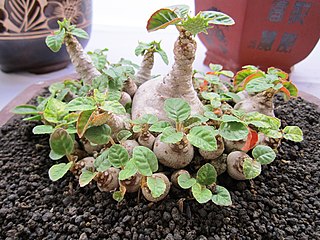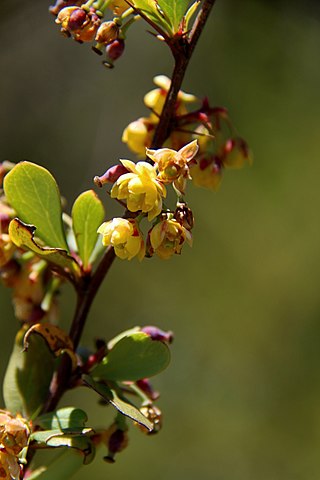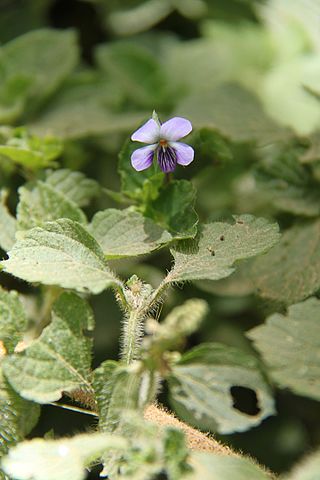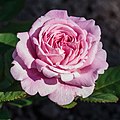
Hibiscus is a genus of flowering plants in the mallow family, Malvaceae. The genus is quite large, comprising several hundred species that are native to warm temperate, subtropical and tropical regions throughout the world. Member species are renowned for their large, showy flowers and those species are commonly known simply as "hibiscus", or less widely known as rose mallow. Other names include hardy hibiscus, rose of sharon, and tropical hibiscus.

Stephanotis is a genus of flowering plants first described in 1806. The name derives from the Greek stephanōtís fit for a crown, derivative of stéphanos (masculine) crown. It contains evergreen, woody-stemmed lianas with a scattered distribution in several tropical and subtropical regions.

The Southwestern Arabian montane woodlands is a xeric woodland ecoregion in the southwestern Arabian Peninsula.

Aneilema is a genus of monocotyledonous plants of approximately 60 species. The vast majority of the species are native to sub-Saharan Africa, but a few are found in Oceania and one, Aneilema brasiliense, is from South America. It is the third largest genus in the family Commelinaceae after Commelina and Tradescantia, and it is one of only six genera in the family to occur in both the Eastern Hemisphere and the Western Hemisphere.

Balanites aegyptiaca is a species of tree, classified as a member of either the Zygophyllaceae or the Balanitaceae. This tree is native to much of Africa and parts of the Middle East.
Ampelocissus abyssinica is a large climbing vine native to southeast Ethiopia, where it is known in the Afaan Oromo language by the name teru, and is used as a herbal treatment for the medical condition known as black leg. Its first botanical description was in 1847 as Vitis abyssinica, that name being the basionym for its treatment here under the genus Ampelocissus.
Buddleja polystachya is a multi-branched shrub or occasionally small tree endemic to the semi-arid highlands flanking the Red Sea in Eritrea, Ethiopia, Saudi Arabia, Somalia and Yemen, where it grows in secondary scrub or around forest, often along watercourses, at elevations of between 2,200 and 3,600 m; its range extends southward into the highlands of Kenya and Tanzania. The species was named by Georg Fresenius in the early part of the 19th century.
Colotis daira, the black-marked orange tip, is a butterfly in the family Pieridae. It is found in the Nigeria, Sudan, Ethiopia, Somalia, Saudi Arabia, Yemen, Oman, Kenya and Tanzania. The habitat consists of dry savanna.

Dorstenia foetida, also known as grendelion, is a succulent plant in the genus Dorstenia, which is native to Eastern Africa and Arabia. It is a very variable species with a wide distribution.

Ficus vasta is a fig plant found in Ethiopia and Yemen. The tree is a species of sycamore-fig.

Berberis holstii is a spiny evergreen shrub assigned to the barberry family, with simple leaves, hanging panicles with a few yellow flowers and eventually blackish-blue berries. It is one out of only species of Berberis that grow in the wild in Africa, where it can be found at high altitudes in Tanzania, Uganda, Kenya, Ethiopia, Somalia, and Malawi. It is also reported from Yemen and Oman. In Malawi it is known as Kayunga, while in Ethiopia it is called Gewo, Yeset af in Amharic, as well as Zinkila, a name also used in the Afar language, and Godxantool in the Somali language.

Rosa brunonii is a species of flowering plant in the family Rosaceae. It is commonly known as the Himalayan musk rose. It is a deciduous or semi-evergreen climber that typically grows at altitudes of 1200–2400 meters.
Balanites rotundifolia, known in Swahili as Mbamba ngoma is a spiny bush or small tree from eastern Africa and southern Arabia. It is a member of the caltrop family, Zygophyllaceae.

Viola abyssinica is a low perennial plant with long trailing stems and whitish or light purple flowers with purple markings on the lip, that is assigned to the violet family. In the wild it grows in moist grassland, forest glades and margins, at altitudes between 1200 and 3400 m (3900–11.000 ft), in eastern Africa, from South Africa to Ethiopia, in Cameroun and Nigeria, and on Madagascar and Bioko. Vernacular names are bezongozongo in Madagascar, and dukunsha in Ethiopia.

Lippia abyssinica, or koseret, is a species of flowering plant in the verbena family, Verbenaceae. It is endemic to Ethiopia but cultivated throughout tropical African countries. The specific epithet abyssinica derives from Latin and means 'of or from Ethiopia (Abyssinia)'.
Kleinia odora is found in Ethiopia, Somalia, Yemen and Saudi Arabia. It is distinguished by having succulent stems or leaves. It is common in low dry hills along coastal plains. It forms large clumps bearing dense clusters of cream or whitish flowers on the tips of the pencil-like stems.
Pollichia campestris, commonly known as waxberry or barley sugar bush, is a herbaceous plant in the family Caryophyllaceae and the only species in the monotypic genus Pollichia. It is found in southern and eastern Africa and in the Arabian peninsula.

Sideroxylon mascatense is a species of flowering plant in the family Sapotaceae.
Fumaria abyssinica is an herbaceous annual plant in the poppy family Papaveraceae. It is native to East Africa and the Arabian Peninsula. It grows in upland rainforest and bamboo forest, and has become a weed in local farms.

Asparagus africanus, also known as African asparagus, bush asparagus, wild asparagus, climbing asparagus fern, ornamental asparagus and sparrow grass, is an African species of plant that is found in a variety of habitats. It has multiple medicinal properties and is used to treat various ailments.














